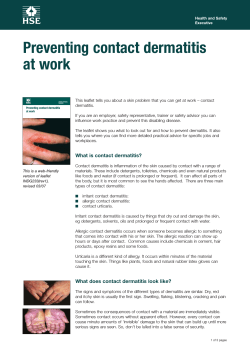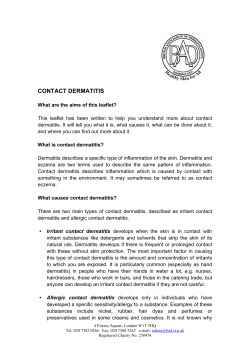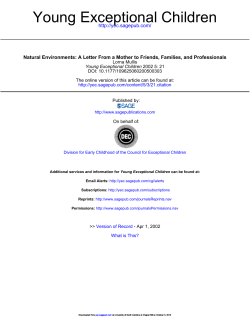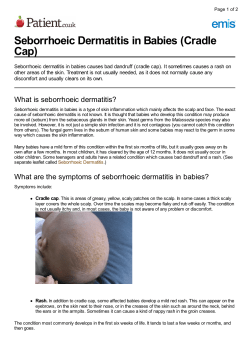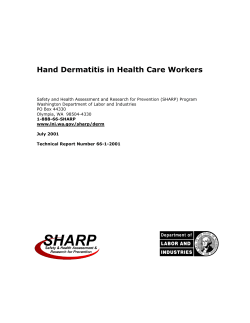
Jacquet Erosive Diaper
Jacquet Erosive Diaper Dermatitis: A Complication of Adult Urinary Incontinence Livia Van; Mandy Harting, MD; Ted Rosen, MD Jacquet erosive diaper dermatitis is typically described as a severe irritant dermatitis of the perianal region. However, Jacquet erosive diaper dermatitis, perianal pseudoverrucous papules and nodules, and granuloma gluteale infantum/ adultorum have been regarded as discrete entities or all part of the same clinical spectrum, representing the result of chronic, severe, irritant contact dermatitis. We present a case of Jacquet erosive diaper dermatitis and a discussion of the clinical spectrum of diseases to which it belongs. Cutis. 2008;82:72-74. Case Report A 77-year-old man presented to the dermatology clinic with complaints of itching and burning of the buttocks of 2 years’ duration. His medical history included prostate cancer treated with radical prostatectomy 3 years prior to clinical presentation. Postoperatively, he experienced chronic urinary incontinence and, consequently, wore disposable diapers. The patient was afebrile and in no acute distress. Site-specific physical examination revealed bilateral, pink, moist perianal plaques and discrete, red, slightly eroded papulonodules within the solid plaques of the gluteal cleft (Figure). The plaques had a white pastelike residue at both the center and periphery. The aforementioned white borders were positive for candidal infection on potassium hydroxide examination. However, the eruption lacked both the pustules and the satellite array prototypical of cutaneous candidiasis. Accepted for publication November 14, 2007. From Baylor College of Medicine, Houston, Texas. The authors report no conflict of interest. Correspondence: Mandy Harting, MD, 1514 W Webster St, Houston, TX 77019 (msharting@sbcglobal.net). 72 CUTIS® Prior to our evaluation, the patient tried many therapies during a 2-year period with no resolution. Treatment with numerous topical antifungal and anti-Candida medications, including clotrimazole cream and miconazole nitrate powder, were unsuccessful. He was subsequently given oral fluconazole by his primary care physician approximately 8 months prior to presentation, also with no benefit. No improvement following application of topical steroids or emollients was noted. Our working diagnosis was Jacquet erosive diaper dermatitis confounded by moniliasis. We treated the patient with zinc oxide barrier paste and naftifine hydrochloride cream 1% twice daily. We recommended more frequent diaper changes as well as regular cleansing and drying of the affected area to improve hygiene. Along with these treatments, our patient received only one 200-mg dose of oral fluconazole for candidal superinfection. Despite the use of initial anti-Candida medication, our patient did not begin to see improvement of his skin lesions or symptoms until approximately 6 weeks after strict diaper hygiene and use of barrier paste and emollients. Comment Prior to Jacquet’s recognition of erosive diaper dermatitis as a clinical entity in 1905,1 infants with this unique presentation of primary irritant diaper dermatitis were thought to have congenital syphilis. Also known as erythema papuloerosive of Sevestre and Jacquet, dermatitis syphiloides posterosiva, or pseudolues papulosa, Jacquet erosive diaper dermatitis is a rare form of ulcerating severe irritant diaper dermatitis affecting occluded skin exposed to urine and/or feces for a prolonged period of time.1-3 Lesions are localized to the genital and/or perianal skin, appearing as nonconfluent, small, well-demarcated papules and nodules measuring 2 to 8 mm in diameter Jacquet Erosive Diaper Dermatitis Bilateral, pink, moist perianal plaques and discrete, red, slightly eroded papulonodules within the solid plaques of the gluteal cleft, characteristic of Jacquet erosive diaper dermatitis. with central umbilication and superficial erosions or ulcers, often with heaped-up borders. Mucosal tissue generally is spared.2,4-6 Biopsies may show acanthosis; hyperkeratosis; spongiosis; superficial ulceration; and a mixed dermal inflammatory infiltrate consisting of neutrophils, lymphocytes, and plasma cells.2,6 Because histopathologic characteristics lack specificity, diagnosis remains largely clinical. The prevalence of Jacquet erosive diaper dermatitis in the general pediatric population has dramatically declined since the advent of modern disposable diapers, but occasional reports of its occurrence in older children and adults still exist.2,4,5,7 Some researchers believe that Jacquet erosive diaper dermatitis exclusively affects patients with chronic urinary and/or fecal incontinence.7,8 Multiple elements contribute to the pathogenesis of Jacquet erosive diaper dermatitis. Persistent occlusion, maceration, friction, irritant agents such as urine and stool, and bacterial colonization may be contributing factors.2 Prolonged contact with urine under occlusion compromises skin integrity and renders it more permeable to irritants, the most potent being pancreatic proteases and lipases present in feces.1 Urea-splitting bacteria in feces release ammonia, creating an elevated pH environment that increases fecal enzyme activity. Lipase activity also is potentiated by the presence of bile salts. Friction generated from the diaper during movement causes further mechanical damage to macerated skin.1,3,5,6 Ammonia applied to intact skin does not produce erythema, but it does inflame already traumatized skin.1 Other diagnoses to consider in the setting of an erosive papulonodular eruption of the perineal region should include secondary syphilis, condyloma acuminata, vegetative herpes simplex, acrodermatitis enteropathica, cutaneous Crohn disease, Langerhans cell histiocytosis, Candida diaper dermatitis, neoplasm, and lichen planus.2,3,5 Perianal pseudoverrucous papules and nodules and granuloma gluteale infantum/adultorum are 2 other forms of irritant dermatitis affecting the genital, inguinal, and perineal regions that may be difficult to distinguish from Jacquet erosive diaper dermatitis because of overlapping clinical appearance. Typically, perianal pseudoverrucous papules and nodules, in contrast with Jacquet erosive diaper dermatitis, are characterized by an erythematous perianal plaque comprising multiple small, shiny, flattop, round, smooth, red, moist papules and nodules, though clinical overlap is common.9 Lesions associated with urostomies have been noted to have a wartlike appearance.10 Microscopically, one may see spongiosis and epidermal acanthosis, but notably, perianal pseudoverrucous papules and nodules lack a dense dermal inflammatory infiltrate.8,10 By contrast, granuloma gluteale infantum/adultorum classically presents as large, firm, reddish purple nodules and plaques on the medial aspects of the thighs, pubic area, scrotum, and buttocks. These lesions are granulomatous in clinical appearance but histologically do not demonstrate multinucleated giant cells or other features of well-developed granulomas. Granuloma gluteale infantum/adultorum is distinguished from perianal pseudoverrucous papules and nodules and Jacquet erosive diaper dermatitis by the distribution pattern that overlies the convex parts of the gluteal region and the presence of a dense mixed dermal inflammatory infiltrate. 8,10 Granuloma gluteale infantum/adultorum usually affects a younger patient VOLUME 82, JULY 2008 73 Jacquet Erosive Diaper Dermatitis population, in contrast to Jacquet erosive diaper dermatitis, which has been described in adult and pediatric populations.2,4,8 Unlike perianal pseudoverrucous papules and nodules and Jacquet erosive diaper dermatitis, granuloma gluteale infantum/ adultorum is not limited to patients with incontinence. Halogenated topical steroids, candidal infection, powders, plastic pants, and the presence of a primary irritant dermatitis have all been implicated as potential etiologic factors.8,10 Regardless of the final classification, management of incontinence most effectively brings about resolution of Jacquet erosive diaper dermatitis. Barrier agents such as zinc oxide ointment, white petrolatum, and sucralfate are useful adjuncts to protect the skin from irritants and moisture. Antifungal creams and oral antibiotics may be beneficial for suspected or proven superinfection. If hygiene is maintained and the skin is kept clean and dry, relapses are uncommon.1,2,6 In our patient, we support the diagnosis of Jacquet erosive diaper dermatitis with superimposed moniliasis rather than an atypical cutaneous candidiasis for many reasons. First, the patient’s clinical presentation was typical of Jacquet erosive diaper dermatitis. Second, despite prior treatment with numerous topical antifungal and anti-Candida medications, including oral fluconazole, our patient showed no signs of improvement in the 2 years prior to presentation to the dermatology clinic. Furthermore, our patient did not improve in the few weeks following our own anti-Candida treatment. Aggressive changes in his diaper hygiene and use of barrier paste and emollients were noted to produce a gradual improvement in his condition. Finally, although there are no specific cases in the literature of Jacquet erosive diaper dermatitis occurring with a secondary candidal superinfection, it is controversial if Jacquet erosive diaper dermatitis, perianal pseudoverrucous papules and nodules, and granuloma gluteale infantum/ adultorum are discrete entities or all part of the same clinical spectrum, representing the result of chronic, severe, irritant contact dermatitis.5,10 Overlapping 74 CUTIS® features of all 3 conditions have been reported, and some groups have suggested combining the terms as severe diaper dermatitis or erosive papulonodular dermatosis to minimize confusion.5,10 If these diseases truly represent a clinical spectrum, there is a high likelihood of Candida exacerbating Jacquet erosive diaper dermatitis, as the existing literature already supports its role in the exacerbation of granuloma gluteale infantum.8,10 References 1.Atheeton DJ. The neonate. In: Rook A, Wilkinson DS, Ebling FJG, eds. Textbook of Dermatology. London, England; Blackwell Scientific; 1998:468-472. 2.Virgili A, Corazza M, Califano A. Diaper dermatitis in an adult: a case of erythema papuloerosive of Sevestre and Jacquet. J Reprod Med. 1998;43:949-951. 3.Rodríguez Cano L, García-Patos Briones V, Pedragosa Jové R, et al. Perianal pseudoverrucous papules and nodules after surgery for Hirschsprung disease. J Pediatr. 1994;125(6, pt 1):914-916. 4.Hara M, Watanabe M, Tagami H. Jacquet erosive diaper dermatitis in a young girl with urinary incontinence. Pediatr Dermatol. 1991;8:160-161. 5.Rodriguez-Poblador J, González-Castro U, HerranzMartínez S, et al. Jacquet erosive diaper dermatitis after surgery for Hirschsprung disease. Pediatr Dermatol. 1998;15:46-47. 6.Kazaks EL, Lane AT. Diaper dermatitis. Pediatr Clin North Am. 2000;47:909-919. 7.Silverberg NB, Laude TA. Jacquet diaper dermatitis: a diagnosis of etiology [letter]. Pediatr Dermatol. 1998;15:489. 8.De Zeeuw R, Van Praag MC, Oranje AP. Granuloma gluteale infantum: a case report. Pediatr Dermatol. 2000;17:141-143. 9.Goldberg NS, Esterly NB, Rothman KF, et al. Perianal pseudoverrucous papules and nodules in children. Arch Dermatol. 1992;128:240-242. 10.Robson KJ, Maughan JA, Purcell SD, et al. Erosive papulonodular dermatosis associated with topical benzocaine: a report of two cases and evidence that granuloma gluteale, pseudoverrucous papules, and Jacquet’s erosive dermatitis are a disease spectrum. J Am Acad Dermatol. 2006;55 (suppl 5):S74-S80.
© Copyright 2025



